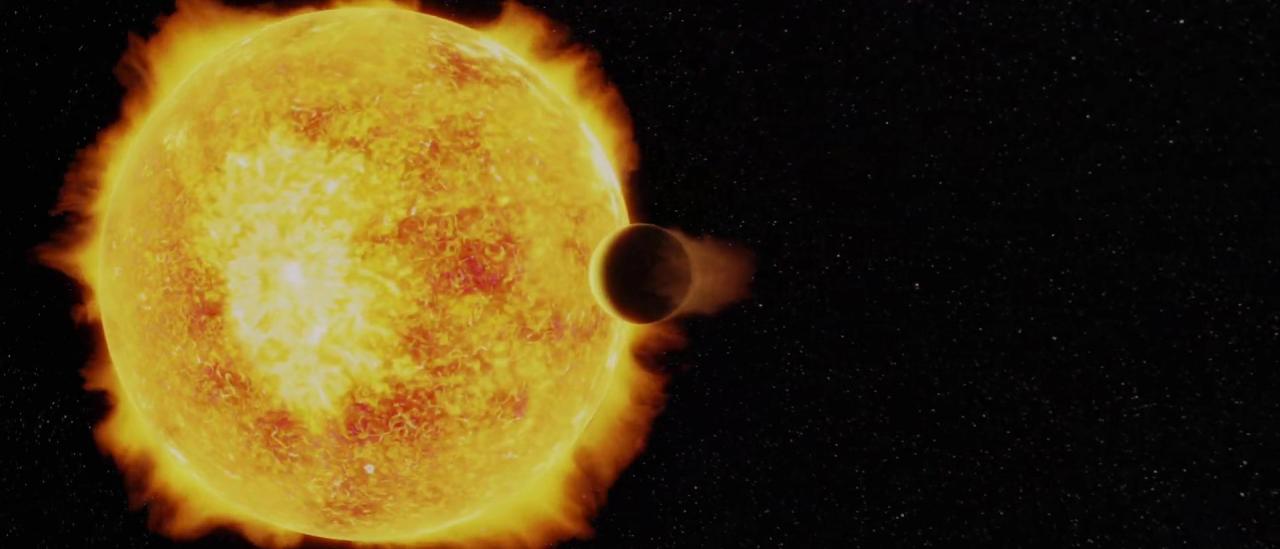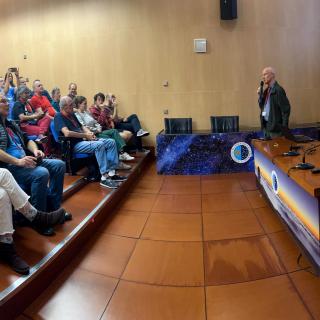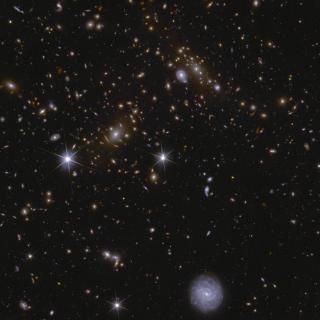A team of astronomers from the University of Chile, in collaboration with the Instituto de Astrofísica de Canarias (IAC) and the University of La Laguna (ULL), has discovered the first “ultrahot Neptune”, which is in orbita round the nearby star LTT 9779. The planet is so close to its star that its year lasts only 19 hours, and the star’s radiation heats the planet to more than 1,700 degrees centigrade. At those temperaturas, the heavy elements such as iron can be ionized in the atmosphere and molecules can dissociate, which makes this a unique laboratory for studying the chemistry of planets outside the Solar System. The discovery was recently published in Nature Astronomy.
This planet has twice as much mass as Neptune, but it is a bit bigger, so its density is similar. The scientists think that this planet, named as LTT 9779b, must have a huge nucleus, 28 times the mass of the Earth, and an atmosphere which makes up some 9% of its total mass.
The age of the system is about half the age of the Sun, some 2,000 million years. However, given the intense radiation of the star, we would not expect a planet similar to Neptune to keep its atmosphere for so long, which implies an intriguing mystery: how did such an improbable system come to exist?
“LTT 9779 is a star similar to the Sun 260 light years away, which is a stone’s throw in astronomical terms” -comments Enric Pallé, an IAC researcher and a co-author of the article-. “It is very rich in metals, with twice as much iron as the Sun’s atmosphere, which could indicate that the planet was originally a much bigger gas giant, because those types of planets form preferentially near to stars with high iron abundance”.
The first hints of the existence of the planet came from observations by NASA’s TESS satellite, as part of its mission to discover planets in transit orbiting nearby bright stars around the whole sky. These transits occur when a planet passes directly in front of its parent star, and blocks a part of the light from the star. The quantity of light blocked is a measure of the size of the planet.
The signal of a transit was quickly confirmed at the beginning of November 2018 as produced by a body of planetary mass, using observations taken with HARPS (High Accuracy Radial-velocity Planet Searcher), on the 3.6m telescope of ESO’s La Silla observatory in northern Chile. HARPS uses the method of radial velocity to measure the masses of planets, and derive their other orbital characteristics. When an object is found via its transit measuring its radial velocity are an efficient way to confirm that it is a planet. For LTT 9779b, the team could confirm the nature of the planet after only a week’s observations.
“Discovering LTT 9779b so early in the TESS mission was a complete surprise. The majority of transit events with periods of less than one day are false positives”, explains James Jenkins, a Professor in the Astronomy Department of the University of Chile, and first author on the paper.
The planet was found in the second of the 26 segments of observations which TESS was to observe over the full sky. Given that no similar exoplanet had been discovered in the precursor missions to TESS (Kepler and K2), the fins was even more exciting.
“We chose this candidate from a TESS alert due to its very short orbital period. After we inspected the light curve, we found that it was a good candidate for an upcoming observing campaign lasting one week on the HARPS spectrograph at La Silla”, says Matías Díaz, a doctoral student at the University of Chile and a coauthor of the article.
LTT 9779b is a rare case, because it is a part of planetary parameter space with a sparse population. “The planet is found in what is known at the “Neptune Desert”, a region without planets when we look at the population in terms of the masses and also the sizes of planets. Although freezing giants seem to be a rather common sub-product of planet formation, this is not true close to their stars. We think that these planets are stripped of their atmospheres by the star’s radiation shortly after they form, and they end up as planets with so-called ultrashort periods”, adds Díaz.
The Kepler mission found that the planets with ultra-short periods, those which orbit their stars in one day or less, are mainly large gas giants, or small rocky planets. Our models say that planets such as LTT 9779b should be stripped of their atmospheres by a process called photoevaporation due to their proximity to their stars. The big gas giants have strong gravitational fields, which can retain their atmospheres, so that we end up with a shortage of planets like Neptune with very short orbital periods.
“Models of planetary structure tell us that this planet must be dominated by a giant nucleus, but crucially, that there must be two or three Earth masses of atmospheric gas. But if the star is as old as it is, why does this atmosphere exist? If LTT 9779b started life as a gas giant then a process called overflowing its Roche lobe could have transferred significant quantities of gas from its atmosphere to the star”, explains Jenkins.
Overflowing its Roche lobe is a process whereby a planet is so close to its star that the stronger gravity of the star can capture the outer layers of the planet, causing them to be transferred to the star, and significantly reducing the mass of the planet. The models do predict results similar to the LTT 9779 system, but they also need some adjustments.
El planeta está muy caliente, lo que motiva la búsqueda de elementos más pesados que el hidrógeno y el helio, junto con núcleos atómicos ionizados. Es aleccionador pensar que este "planeta improbable" es probablemente tan raro que no encontraremos otro laboratorio como este para estudiar en detalle la naturaleza de los Neptunos ultracalientes.
“It is also possible that LTT 9779b reached its present orbit quite late, so that there has not been time for its atmosphere to be stripped. Collisions with other planets in the system could have thrust it towards the star. In fact, given that it is a unique world, even more exotic scenarios are possible”, adds Pallé.
As the planet has a significant atmosphere and orbits a relatively bright star, future studies of the planet’s atmosphere could explain the mysteries of how those planets form, how they evolve, and the details of their nature.
The planet is very hot, which makes us look for elements heavier than hydrogen and helium, as well as atoms which are ionized. It is encouraging to think tha this “improbable planet” could be so rare that we will not find another laboratory like this to study in detail the nature of the ultrahot Neptunes.
Article: Jenkins et al. “An ultrahot Neptune in the Neptune desert”, Nature Astronomy, 2020. DOI: https://www.nature.com/articles/s41550-020-1142-z
Contact at the IAC:
- Enric Pallé: epalle [at] iac.es (epalle[at]iac[dot]es)
Vídeo about its descovery: https://www.youtube.com/watch?v=6y0BqYBaB0c




